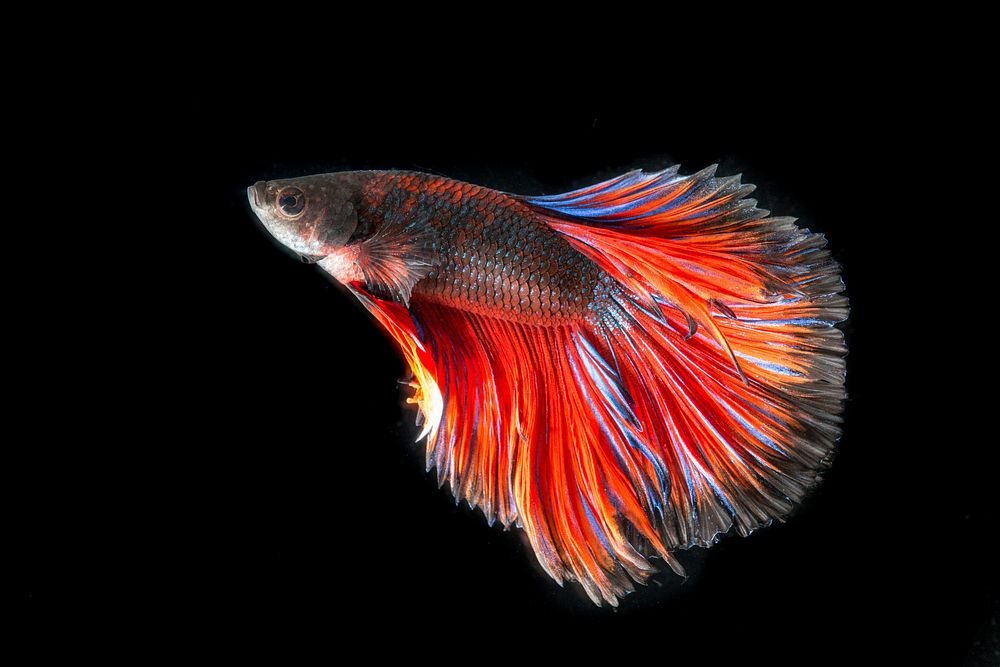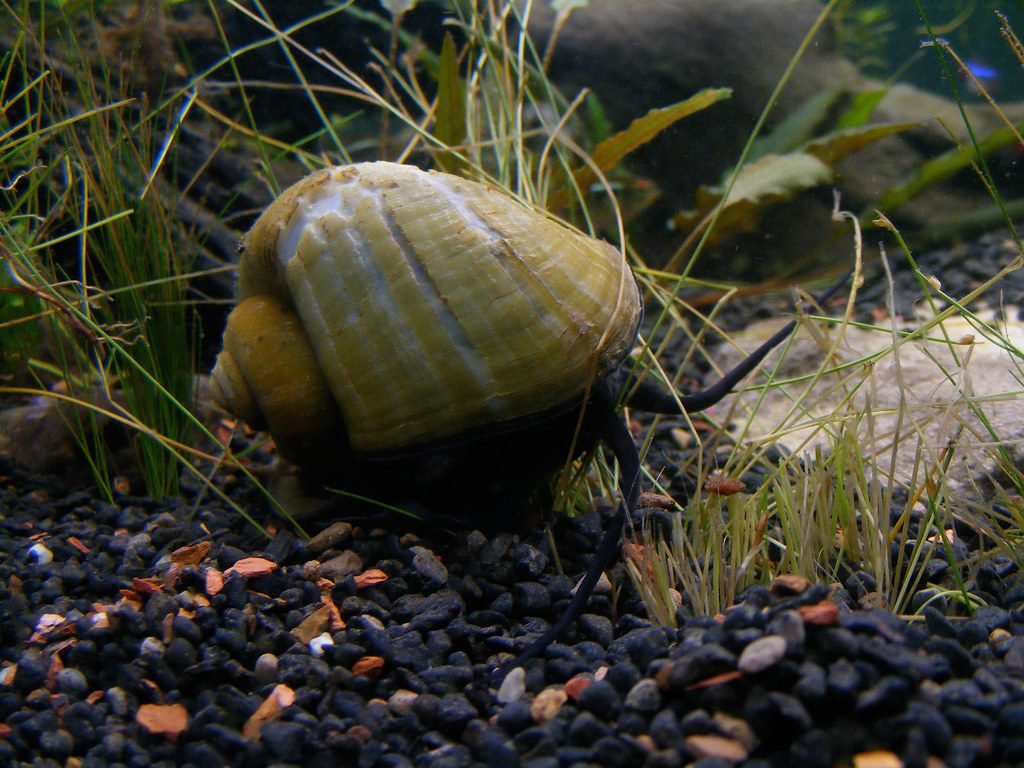


Why can’t fish live in tap water? [2024 Guide]
February 23, 2024


Can snakes be pets? (Do they like being a pet?) Pros/Cons
February 24, 2024Betta fish and snails are both popular choices for aquarium lovers. Betta fish, known for their vivid colors and flowing fins, are small, easy to care for, and can live happily in small tanks. On the other hand, snails are peaceful creatures that help keep the tank clean by eating algae and leftover food.
Combining different creatures in one tank ensures they can live together without problems. So here’s the answer:
Certainly, betta fish and snails can be excellent companions in the same tank! Think of it as pairing a serene, somewhat reserved individual (the betta) with a laid-back, keep-to-themselves kind of roommate (the snail).
This means checking if they need the same kind of water and if they won’t hurt each other. Understanding which pets can share a home helps keep everyone healthy and happy.
Betta fish
Betta fish are known for their distinctive personalities and striking appearance. They prefer a peaceful habitat with plenty of hiding spots and plants, which mimic their natural environment in shallow, warm waters.
The ideal water conditions for bettas include a temperature range of 76-82 degrees Fahrenheit, a neutral pH, and clean water with minimal current. While they can adapt to smaller spaces, a larger tank allows a quality of water and more room to explore.
One of the most notable characteristics of betta fish is their temperament. They are solitary beings and can become aggressive towards other fish, especially those with similar appearances or that invade their space.
This aggression is more pronounced in males, who are known to attack each other if housed together. However, with proper tank management and the selection of compatible tank mates like certain snails, it’s possible to create a harmonious living environment for bettas.


Red Betta Fish
Also, Read: Why can’t fish live in tap water? [2024 Guide]
Can snails live with betta fish?
Yes, bettas and snails can indeed share an aquarium. In fact, introducing snails to a betta tank is often a beneficial decision. Both species can thrive in similar water conditions, and since snails are resilient and non-aggressive, they pose no threat to bettas.
However, some factors should be considered when mixing snails with betta fish.
Bettas have a territorial nature and may show aggression towards what they perceive as intruders, which can sometimes include snails, though this largely depends on the individual betta’s personality.
Moreover, it’s worth noting that bettas have predatory instincts and might attempt to prey on snails.
While most snails have a sturdy build (mainly the adults), a betta with a strong predatory drive might stress a less bold snail to the extent of causing harm. Thus, ensuring ample hiding spots for snails to retreat and stay out of sight is crucial.
Despite these considerations, the combination of snails and betta fish is a well-established match that has been successful in numerous aquarium setups.
This arrangement can also offer advantages for your betta, which will be discussed further in the following section.


Mystery Snail
Must Read: Why Does My Fish Tank Lose Water? Causes & Solutions!
What snail species can live with betta fish in your tank?
Several snail species are known for their compatibility with betta fish, making them excellent choices for a shared aquarium. These species are generally peaceful and hardy and can thrive in the same water conditions as bettas.
Here are some of the best snail species to consider:
1: Nerite Snails
- Characteristics: Known for their incredible algae-eating ability, Nerite Snails are one of the most common choices for betta tanks. They come in various colors and patterns, adding visual interest to the aquarium.
- Benefits: Excellent at controlling algae without overpopulating the tank, as they cannot reproduce in freshwater.
2: Mystery Snails
- Characteristics: Mystery Snails are larger and come in various colors, including gold, blue, and black. They are known for their peaceful nature and exciting behaviors.
- Benefits: Besides algae, they also clean up leftover food and plant debris, helping to keep the tank clean.
3: Ramshorn Snails
- Characteristics: Recognizable by their spiraled shell, Ramshorn Snails can be an attractive addition to the aquarium. They are available in red, brown, and sometimes blue variants.
- Benefits: Effective cleaners that eat algae, waste, and dead plant material. However, they can reproduce quickly if overfed.
4: Malaysian Trumpet Snails
- Characteristics: These snails have elongated, cone-shaped shells and are nocturnal. They burrow into the substrate during the day.
- Benefits: They aerate the substrate by burrowing, which can prevent the buildup of dangerous gases and promote a healthy tank environment.
5: Japanese Trapdoor Snails
- Characteristics: These snails are known for their large, rounded shells and ability to withstand cooler temperatures. They are less common but highly valued for their algae-eating habits and low aquarium reproduction rate.
- Benefits: Excellent for algae control and will not overrun the tank due to their controlled breeding.
6: Assassin Snails
- Characteristics: As their name suggests, Assassin Snails are predatory and will actively hunt and consume other snail species. They have a distinctive yellow and brown striped shell.
- Benefits: They can help control the population of unwanted snails in the tank, making them a good choice if you’re dealing with a snail infestation.
7: Pond Snails
- Characteristics: Often introduced accidentally through live plants, Pond Snails are small and can reproduce quickly. They are very hardy and adaptable.
- Benefits: They are efficient cleaners, eating algae, decaying plants, and leftover food. However, their rapid reproduction rate requires monitoring.
8: Ivory Snails
- Characteristics: Large, striking snails with a beautiful, glossy ivory-colored shell. They are peaceful and can grow significantly compared to other snail species.
- Benefits: Besides being a visually appealing addition, they contribute to the tank’s cleanliness by consuming algae and detritus.
9: Rabbit Snails
- Characteristics: Rabbit Snails have elongated shells and are popular for their unique appearance and slow growth. They come in various colors and patterns.
- Benefits: They are great for tank maintenance, feeding on leftover food, algae, and decaying plant matter. Their reproduction rate is slower than many other snails, making them easier to manage.
Is it possible for betta fish to kill snails in your tank?
Yes, betta fish can potentially harm or kill snails, although such behavior largely depends on the temperament of the individual betta and the type of snail. Bettas are known for their territorial and sometimes aggressive nature, particularly towards other bettas and fish with similar body shapes or finnage. However, their aggression can sometimes extend to snails, significantly smaller or more delicate species.
Preventing Harm to Snails
- Provide Hiding Places: Ensure the aquarium has plenty of hiding spots for snails, such as plants, rocks, or decorations, to escape betta aggression.
- Choose Larger, Hardier Snail Species: Opting for larger snails with robust shells can minimize the risk of bettas harming them.
- Monitor Interactions: When introducing snails to a betta tank, closely monitor their interactions. If the betta exhibits aggressive behavior, it may be necessary to separate them.
What other suitable mates can coexist with betta fish in a fish tank?
Betta fish can live harmoniously with several peaceful and non-intrusive species that do not compete for space or provoke their territorial behavior.
Choosing tank mates that thrive in similar water conditions and have a calm demeanor is crucial.
- Corydoras Catfish: Small, peaceful bottom dwellers that keep to themselves.
- Harlequin Rasboras: Active yet peaceful fish that prefer to swim in the middle to upper levels of the tank.
- Neon Tetras: Small and non-aggressive, known for their bright colors and schooling behavior.
- Ember Tetras: Another small, schooling fish that tends to avoid conflict with bettas.
- Ghost Shrimp: Transparent and primarily unnoticed by bettas, excellent for cleaning up.
- African Dwarf Frogs: Peaceful and can coexist with bettas if fed properly to avoid competition.
- Kuhli Loaches: Shy and nocturnal, mostly hidden or burrowing in the substrate.
Editor’s Pick: Can Fish Survive in Bowls? Should You Keep One?
Conclusion
In conclusion, betta fish can coexist in a harmoniously arranged aquarium with various tank mates, including certain snails and peaceful fish species. By understanding each species’ needs and behaviors, aquarists can create a vibrant, diverse, and healthy ecosystem that promotes the well-being of bettas alongside their companions.



